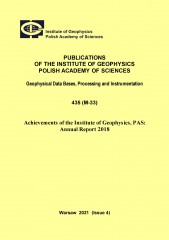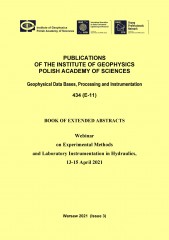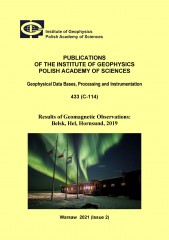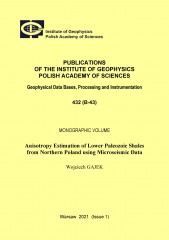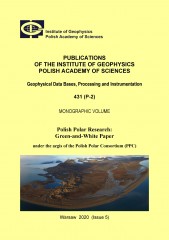BROWSE - VOLUME LIST
- A - Physics of the Earth's Interior
- B - Seismology
-
C - Geomagnetism
C-119, C-118, C-117, C-116, C-115, C-114, C-113, C-112, C-111, C-110, C-109, C-108, C-107, C-106, C-105, C-104, C-103, C-102, C-101, C-100, C-99, C-98, C-97, C-96, C-95, C-94, C-93, C-92, C-91, C-90, C-89, C-88, C-87, C-86, C-85, C-84, C-83, C-82, C-81, C-80, C-79, C-78, C-77, C-76, C-75, C-74, C-73, C-72, C-71, C-70, C-69, C-68, C-67, C-66, C-65, C-64, C-63, C-62, C-61, C-60, C-59, C-58, C-57, C-56, C-55, C-54, C-53, C-52, C-51, C-50, C-49, C-48, C-47, C-46, C-45, C-44, C-43, C-42, C-41, C-40, C-39, C-38, C-37, C-36, C-35, C-33, C-32, C-31, C-30, C-29, C-28, C-27, C-26, C-25, C-24, C-23, C-22, C-21, C-20, C-19, C-18, C-17, C-16, C-15, C-14, C-13, C-12, C-11, C-10, C-9, C-8, C-7, C-6, C-5, C-4, C-3, C-2, C-1
-
D - Physics of the Atmosphere
D-79, D-78, D-77, D-76, D-75, D-74, D-73, D-72, D-71, D-70, D-69, D-68, D-67, D-66, D-65, D-64, D-63, D-62, D-61, D-60, D-59, D-58, D-57, D-56, D-55, D-54, D-53, D-52, D-51, D-50, D-49, D-48, D-47, D-46, D-44, D-45, D-43, D-42, D-41, D-40, D-39, D-38, D-37, D-35, D-34, D-33, D-32, D-31, D-30, D-28, D-27, D-26, D-25, D-24, D-23, D-22, D-21, D-20, D-19, D-18, D-17, D-16, D-15, D-14, D-13, D-12, D-11, D-10, D-9, D-8, D-7, D-6, D-5, D-4, D-3, D-2, D-1
- E - Hydrology
- P - Polar Research
- M - Miscellanea
-
Online First
Browse - Volume list
Achievements of the Institute of Geophysics, PAS: Annual Report 2018
Author(s):
Volume: 435
Series: M-33
DOI: 10.25171/InstGeoph_PAS_Publs-2021-044
Volume: 435
Series: M-33
DOI: 10.25171/InstGeoph_PAS_Publs-2021-044
This Monograph, the first one in a series of yearly outlines on the main achievements of the Institute of Geophysics, Polish Academy of Sciences, is a reviewed and edited version of the Annual Report 2018. It provides information about the research done in the seven departments (Seismology, Atmospheric Physics, Lithospheric Research, Theoretical Geophysics, Hydrology and Hydrodynamics, Magnetism, Geophysical Imaging, and Polar and Marine Research), together with the Institute’s infrastructure, instrumentation, projects that have been completed or are underway, as well as editorial, educational, and many other activities.
Book of Extended Abstracts. Webinar on Experimental Methods and Laboratory Instrumentation in Hydraulics, 13-15 April 2021
Author(s):
Volume: 434
Series: E-11
DOI: 10.25171/InstGeoph_PAS_Publs-2021-039
Volume: 434
Series: E-11
DOI: 10.25171/InstGeoph_PAS_Publs-2021-039
The recent development of equipment and software for hydraulic measurements, data analysis, and visualization, has introduced new opportunities but also new challenges for research and technical cadre.
Results of Geomagnetic Observations: Belsk, Hel, Hornsund, 2019
Author(s): Reda J., Neska M., Wójcik S., Czubak P.
Volume: 433
Series: C-114
DOI: 10.25171/InstGeoph_PAS_Publs-2021-002
Volume: 433
Series: C-114
DOI: 10.25171/InstGeoph_PAS_Publs-2021-002
This publication contains basic information on geomagnetic observations carried out in 2019 in three Polish geophysical observatories: Belsk, Hel, and Hornsund. IAGA codes are respectively: BEL, HLP, and HRN. All these observatories belong to the Institute of Geophysics, Polish Academy of Sciences. Observatories Belsk and Hel are located on the territory of Poland, while Hornsund is in Spitsbergen archipelago, under Norwegian administration.In 2019, like in the previous years, the Belsk, Hel, and Hornsund observatories have kept a close collaboration with the world network of geomagnetic observatories INTERMAGNET. The Belsk Observatory joined INTERMAGNET in 1992, Hel in 1999, and Hornsund in 2002.
Anisotropy Estimation of Lower Paleozoic Shales from Northern Poland using Microseismic Data
Author(s): Gajek W.
Volume: 432
Series: B-43
DOI: 10.25171/InstGeoph_PAS_Publs-2021-001
Volume: 432
Series: B-43
DOI: 10.25171/InstGeoph_PAS_Publs-2021-001
Downhole microseismic monitoring is a widely used tool for the assessment of hydraulic fracturing job effectiveness. During the process of fluid injection into the reservoir, new fractures develop due to the induced pressure, which gives rise to microseismic events. Therefore, the knowledge of an accurate velocity model is necessary in order to locate the induced micro-seismic events. Subsurface complexity is often raised by a horizontal layering, an intrinsic anisotropy of shales, and aligned fracture sets. That introduces anisotropic effects into the velocity field. In such a case, the anisotropy should be taken into account during the velocity model building. Otherwise, some errors will be introduced into the microseismic event locations, and hence, the interpretation of treatment effects will be biased. Therefore, this thesis is devoted to the anisotropy estimation using downhole microseismic data.
Polish Polar Research: Green-and-White Paper under the aegis of the Polish Polar Consortium (PPC)
Author(s): Lewandowski M., Polkowska Z., Ziaja W., et al .
Volume: 431
Series: P-2
DOI: 10.25171/InstGeoph_PAS_Publs-2020-006
Volume: 431
Series: P-2
DOI: 10.25171/InstGeoph_PAS_Publs-2020-006
The aim of this document is to present the current state of Polish research in the polar areas, as well as to suggest the main directions for further development of this research, taking into account its educational and cognitive importance and its social and economic utility. The book is addressed to the state administration and the scientific communities in Poland, those already engaged in polar studies as well as those seeking new openings in their current research. The book should also be a starting point for updating the current Polar Research Strategy.


